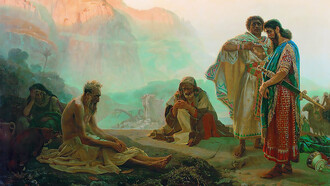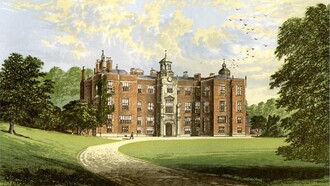Probably, a contemporary consumer of comics would be disappointed if we proposed to him the reading of what was the seed of comics in the 18th century.
For comics to come to look as they do today, they had a long evolution of continuous mutations, the result of the historical context, of new artistic codes, and technical achievements; an evolution marked, from time to time, by great artists.
One of the early pillars in the gestation of what we call “comic” today is William Hogarth, born in 1697 in Bartholomew Close, London.
The artist's importance is manifested in his fame of being recognized as one of the fathers of the comic strip and practically the grandfather of the political cartoon; he moved chameleonically from satire to academicism, from painting to engraving, from sequentialized narration to printmaking. He was a painter, engraver, caricaturist, illustrator, and art critic.
Hogarth not only drew from the influence of his predecessors such as Albrecht Dürer, Pieter Bruegel the Elder, Da Vinci, and Michelangelo, but also from the traumatic experiences of his personal life, such as living with his family in a debtors' prison when he was a child.
Therefore, it is not surprising that his work is populated by gamblers, bad boys, thieves, addicts, and fauna of the London underworld; also, his narrative cycles often end in jail, in the madhouse, or the grave.
In Hogarth's stories, the fate of the characters no longer depends, as in mythological or religious works, on a metaphysical force, but on a moral choice, on a dilemma faced by the character when having to choose between vice and virtue.
In this category are two of his most famous sequentialized works: “A Harlot's Progress,” from 1732, which tells the hapless story of a courtesan, and “A Rake's Progress,” its male counterpart from 1735, which tells the fatal fate of a hardened gambler who ends his days locked up in the madhouse.
Hogarth's versatile work not only opens a window into the history and English society of the 18th century but also shows us fundamental stages in the evolution of comics and political cartoons worldwide, which corresponds to a new way of understanding the world.
His legacy is the product of an era, a time that laid the foundations for the pictorial expressions of the 19th century and that gave rise to contemporary art shortly after. The artist practically belongs to the same group of protagonists of the scientific and philosophical revolution of the late 17th century that founded the rational empirical paradigm in the West and paved the way for the expansion of capitalism.
Hume, Locke, and Newton were the architects of a revolution of ideas that necessarily had its correspondence in the field of the arts. We can risk saying that Hogarth was to political cartoons and English painting what Newton was to physics.
His work, in this sense, is part of the intention of founding a secular artistic tradition; metaphysical motifs or monarchical celebrations give way to representations of the social and political, to the inquiry of contemporary reality.
Hogarth liked to lose himself in walks around Smithfield during the St. Bartholomew's Fair and to wander through the labyrinths that offered a great variety of images rich in characters and spectacles; this vital experience made him compose engravings that led the eye to wander through the plates in search of characters and meanings in intricate compositions.
In his book “Analysis of Beauty” (1753), where he mentions the six principles of artistic beauty (competence, variety, regularity, simplicity, complexity, and quantity), he devotes an entire chapter to talking about the pleasure of the viewer when the gaze hunts, practically, objects and characters.
Hogarth's images can be considered puristic since they offer the viewer a universe of meanings ready to be interpreted.
This characteristic, which researcher Thierry Smolderen calls “polygraphic humorism,” has cast doubt on the nature of political criticism in Hogarth's work since, it is said, it does not manifest dualities or antithetical positions in the face of official discourse, but a multitude of meanings.
But beyond this controversy, the purpose of art for him was the representation of reality through the life experiences of a character, of staging, of telling a story; an idea entirely compatible with enlightenment, with the idea of illuminating, discovering, and explaining.
The observation of daily life, of its miseries and realities, reflected its crudeness necessarily in the comic.
Characters such as Cervantes, Rabelais, and Shakespeare himself, also legitimized the comic through new tragic, burlesque heroes, well received by both the bourgeoisie and the lower strata of society. An example of this is the illustrations for Don Quixote, dated 1726, where the author emphasizes the grotesque over the classical heroic representation of the characters.
The traits that distinguish Hogarth as a popular artist include, among others, the fact that, with his satirical prints, he broke down the cultural boundaries of “high” and “low” culture; he became his own publisher, opting for a low-cost popular production, less prestigious than that of a classical painter, but which popularized him and made him rich quickly.
His engravings demanded a style that was compatible with storytelling, with the contemporary chronicle, and nothing better for that than satire. Hogarth's compositions revolutionized the way images were conceived: between news and illustration, between journalism and the literary.
However, for a modern reader, it is very difficult to find the keys to understanding his works; the distance of time and space makes them incomprehensible and cryptic; however, it is precisely in these works where we find the seed of some elements of political cartoons and contemporary comics.
The keys to its reading can be found in a form of entertainment that, from the second quarter of the eighteenth century, conquered the hearts of all social classes: the theater.
Works such as “A Harlot's Progress” contain plates whose meaning can be read in the light of their time. The artist employs a conventional technique of history painting, which consists of giving us hints in each picture of a narrative sequence.
Beyond the symbols hidden in each plate and beyond the multiplicity of meanings that they can be read in the context of that period, his works have to do with the history of comics because they inaugurate a way of approaching the narrative through images.
Those of the English author are concatenated plates with a recurring fictional character, with a protagonist whose vicissitudes are followed progressively; each image acquires meaning and is enriched in a chronological succession that is part of a broader narrative.
With Hogarth, we can say that we are witnessing the first attempts to move from illustration to narration, to make the verbal text, little by little, a paratext of the images, that the words are subordinated to them and not the opposite.
While modern comics tell us in their frames events that happen every minute or every second, Hogarth's stories unfold over days, months, or years, like in “The Harlot's Progress.”
From Hogarth onward, in general, the career of the comic strip will make its little frames less complicated, sacrificing graphic complexity for narrative complexity, largely driven by the discovery of photography.
Hogarth manages to make the audience become the story's constructor by giving hints as to how it continues. Hogarth, in his work, alludes to the theories of his time, for example, to the “machine world”; hence the constant appearance of the clock as a symbol of the mechanistic idea of the universe.
Together with Rodolphe Töpffer, Richard Felton, or Wilhelm Busch, he disputes the paternity of the first comic strip in history, while political cartoonists such as Thomas Rowlandson or James Gillray were the continuators in the evolution of the modern political cartoon, of which Hogarth is also a precursor.
The satires of 19th-century French lithography in the hands of Daumier and Jean Ignace Grandville are also his heirs, and closer in time we can recognize his influence in caricaturists, cartoonists, and illustrators such as Ronald Searle, Martin Rowson, Steve Bell, Thomas Moore, or Robert Crumb.
His influence is such that, in a premonitory historical coincidence, the father of the political cartoon had a pug dog named Trump.
In 1763, William Hogarth suffered a stroke that left him paralyzed and died in 1764, leaving behind an immense legacy in the fields of aesthetics, linguistics, narratology, sociology, and art history.
Although Hogarth has been buried under Marvel and manga editions, his work gives us very interesting clues to understand the language and evolution of two sisters of today's “iconosphere”: the political cartoon and the comic strip.














